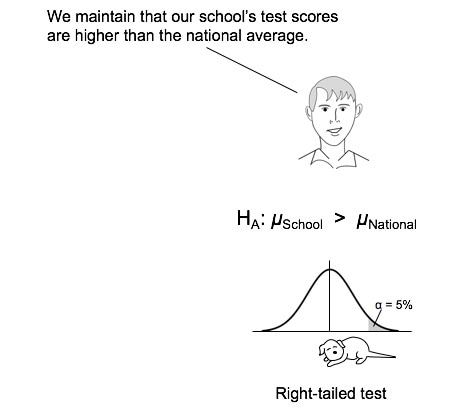|
In last week's tip, we showed how to state the Null Hypothesis as an equation (e.g. H0: μΑ = μΒ). (HA: μA ≠ μB). And the Alternative Hypothesis would be the opposite of that: These work for a 2-tailed (2-sided) test, when we only want to know whether there is a (Statistically Significant) difference between the two Means, not which one may be bigger than the other.
But what if we do care about the direction of the difference? This would be a 1-tailed (1-sided) test. And the Alternative Hypothesis will tell us whether it's right-tailed or left-tailed. (We need to specify the tail for our statistical calculator or software.) How does this work? First of all, it's helpful to know that the Alternative Hypothesis is also known as the "Maintained Hypothesis". The Alternative Hypothesis is the Hypothesis which we are maintaining and would like to prove. For example, let's say our school's test scores are 2 points higher than the national average. We would like to prove that this is a Statistically Significant difference. So, we maintain that our school's scores are higher. And we do a t-test to attempt to prove it. Our Alternative Hypothesis is what we maintain: our school's scores are higher. As shown below, the comparison symbol ">" points to the right, so we have a right-tailed test. (For more on the Alternative Hypothesis, you can see my video.)
0 Comments
Leave a Reply. |
AuthorAndrew A. (Andy) Jawlik is the author of the book, Statistics from A to Z -- Confusing Concepts Clarified, published by Wiley. Archives
March 2021
Categories |




 RSS Feed
RSS Feed